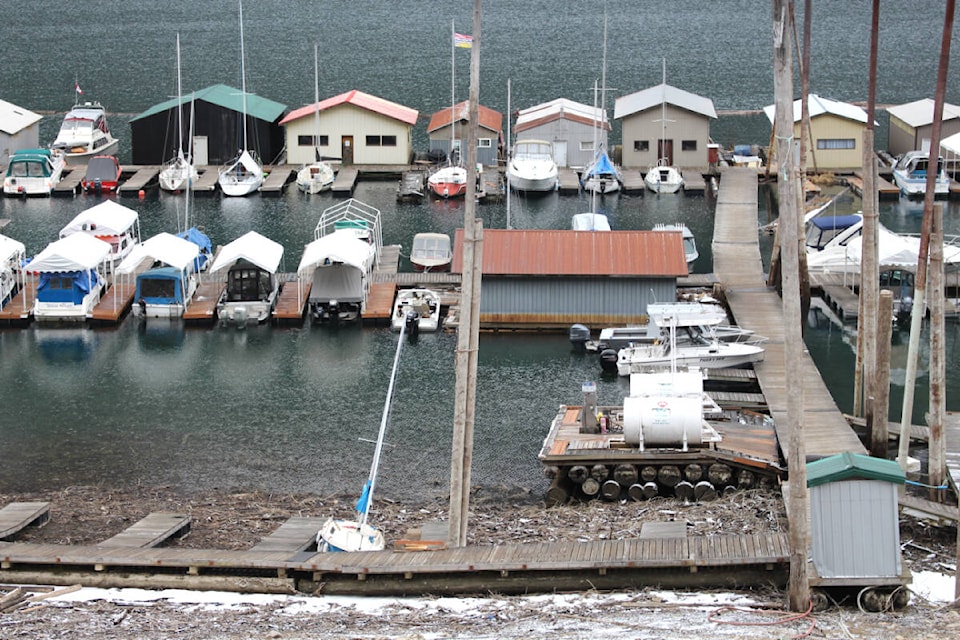Castlegar resident John Russell says he can only remember a few times when the water has been this low out at Scotties Marina on the Lower Arrow Lake where he has kept a boat for many years.
This week when Russell went out to his boat house at the deep side of the marina and turned on his depth finder, the reading came back at six metres.
His spot usually reads about 21 metres.
As of Jan. 7, the Arrow Lakes Reservoir is sitting at an elevation of 424.08 metres at the Fauquier gauge. This is only the third time in the last 22 years that the reservoir has been that low. It is expected to dip another 0.6 metres by the end of January.
Russell is lucky his boat house is out in the deeper water.
At the shoreline a sail boat tilts sideways, completely resting on dry ground. A houseboat has also run aground. Rows of the marina’s docks are completely out of the water as is the boat-in gas pump dock.

Russell says in recent days owners have been scrambling to get their boats out of the water before they get stuck in the mire.
“Most people don’t realize that the water level can change 50 feet in a year,” said Russell. “It is stressful for a lot of people.”
Marina employee Rhonda McLean says each winter one row of docks has to be emptied, but this year the boats in a second row had to be removed as well.
“Customers are not happy,” says McLean, “but they know it is not the marina’s fault and that there really isn’t anything we can do about it.”
McLean says the low water levels have caused damages to the docks that will need some major repairs.
The landscape itself looks completely different from the summer high in July 2022 when the reservoir sat almost 15 metres higher at 438.7 metres.
The boat launch and its dock are now nowhere near the waterline and a soggy shoreline reveals things that are usually hidden.

The sight isn’t unique to Scotties Marina — it’s the same all along the Arrow Lakes.
BC Hydro expects the reservoir to draft to a minimum of 423.6 metres by Jan. 27. That is just at the limit of where the low water level would begin to affect the Needles Ferry at Fauquier.
Spokesperson Mary Anne Coules said that once water levels drop below 423.7 metres “minor operational changes” are necessary to keep the ferry running.
In the last two decades, the lake has dropped to that point twice. In 2001 it hit a low of 422.1 metres and in 2015 it lowered to 423.9 metres.
Coules says the average winter low is around 426.7 metres.
According to BC Hydro, the current low water levels are due to persistent dry conditions across the Columbia Basin.
“Lower-than-average levels are associated with Columbia River Treaty obligations during ‘dry years,’” explained BC Hydro in a special advisory issued on Jan. 4.
“Under dry conditions more water is released from Canadian storage according to the terms of the Columbia River Treaty.”
BC Hydro says it has implemented measures to maintain Arrow Lakes Reservoir levels including increasing generation on the Columbia system.
After the reservoir reaches its expected minimum elevation at the end of January, forecasters expect it to begin to refill and reach approximately 426.7 metres by the end of February.

Even though the water levels this year are lower than usual, they still fall within the normal minimum and maximum water licence levels as well as the full range of storage required under the Columbia River Treaty.
The allowable minimum is 420 metres and the maximum is 440.1 metres.
Water level forecasts are subject to change based on a number of factors, including weather, load requirements, inflows, and other variables. People who may be affected by water level changes are advised to sign up for BC Hydro’s weekly forecast email. Information is also available by calling their toll-free information line at 1-877-924-2444.
READ MORE: Trail RCMP respond to 2 separate stabbings in just over a week
betsy.kline@castlegarnews.com
Like us on Facebook and follow us on Twitter



